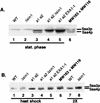Suppression of an Hsp70 mutant phenotype in Saccharomyces cerevisiae through loss of function of the chromatin component Sin1p/Spt2p
- PMID: 9851990
- PMCID: PMC107749
- DOI: 10.1128/JB.180.24.6484-6492.1998
Suppression of an Hsp70 mutant phenotype in Saccharomyces cerevisiae through loss of function of the chromatin component Sin1p/Spt2p
Abstract
The Ssa subfamily of Hsp70 molecular chaperones in the budding yeast Saccharomyces cerevisiae has four members, encoded by SSA1, SSA2, SSA3, and SSA4. Deletion of the two constitutively expressed genes, SSA1 and SSA2, results in cells which are slow growing and temperature sensitive. In this study, we demonstrate that an extragenic suppressor of the temperature sensitivity of ssa1 ssa2 strains, EXA1-1, is a loss-of-function mutation in SIN1/SPT2, which encodes a nonhistone component of chromatin. Loss of function of Sin1p leads to overexpression of SSA3 in the ssa1 ssa2 mutant background, at a level which is sufficient to mediate suppression. In a strain which is wild type for SSA genes, we detected no effect of Sin1p on Ssa3p expression except under conditions of heat shock. Existing data indicate that expression of SSA3 in the ssa1 ssa2 mutant background as well as in heat-shocked wild-type strains is mediated by the heat shock transcription factor HSF. Our findings suggest that it is HSF-mediated induction of SSA3 which is modulated by Sin1p. The EXA1-1 suppressor mutation thus improves the growth of ssa1 ssa2 strains by selectively increasing HSF-mediated expression of SSA3.
Figures







Similar articles
-
Complex interactions among members of an essential subfamily of hsp70 genes in Saccharomyces cerevisiae.Mol Cell Biol. 1987 Jul;7(7):2568-77. doi: 10.1128/mcb.7.7.2568-2577.1987. Mol Cell Biol. 1987. PMID: 3302682 Free PMC article.
-
A heat shock transcription factor with reduced activity suppresses a yeast HSP70 mutant.Mol Cell Biol. 1995 Sep;15(9):4890-7. doi: 10.1128/MCB.15.9.4890. Mol Cell Biol. 1995. PMID: 7651408 Free PMC article.
-
Isolation and characterization of extragenic suppressors of mutations in the SSA hsp70 genes of Saccharomyces cerevisiae.Genetics. 1992 Jun;131(2):277-85. doi: 10.1093/genetics/131.2.277. Genetics. 1992. PMID: 1644272 Free PMC article.
-
The stress response against denatured proteins in the deletion of cytosolic chaperones SSA1/2 is different from heat-shock response in Saccharomyces cerevisiae.BMC Genomics. 2005 Oct 7;6:141. doi: 10.1186/1471-2164-6-141. BMC Genomics. 2005. PMID: 16209719 Free PMC article.
-
Expression of members of the Saccharomyces cerevisiae hsp70 multigene family.Genome. 1989;31(2):684-9. doi: 10.1139/g89-125. Genome. 1989. PMID: 2698838 Review.
Cited by
-
Essentiality of Sis1, a J-domain protein Hsp70 cochaperone, can be overcome by Tti1, a specialized PIKK chaperone.Mol Biol Cell. 2022 Mar 1;33(3):br3. doi: 10.1091/mbc.E21-10-0493. Epub 2021 Dec 22. Mol Biol Cell. 2022. PMID: 34935410 Free PMC article.
-
Displacement of histones at promoters of Saccharomyces cerevisiae heat shock genes is differentially associated with histone H3 acetylation.Mol Cell Biol. 2006 Oct;26(20):7587-600. doi: 10.1128/MCB.00666-06. Mol Cell Biol. 2006. PMID: 17015479 Free PMC article.
-
Evidence that Spt2/Sin1, an HMG-like factor, plays roles in transcription elongation, chromatin structure, and genome stability in Saccharomyces cerevisiae.Mol Cell Biol. 2006 Feb;26(4):1496-509. doi: 10.1128/MCB.26.4.1496-1509.2006. Mol Cell Biol. 2006. PMID: 16449659 Free PMC article.
-
The budding yeast Rad9 checkpoint complex: chaperone proteins are required for its function.EMBO Rep. 2003 Oct;4(10):953-8. doi: 10.1038/sj.embor.embor935. Epub 2003 Sep 5. EMBO Rep. 2003. PMID: 12973299 Free PMC article.
-
Effects of HSP70 chaperones Ssa1 and Ssa2 on Ste5 scaffold and the mating mitogen-activated protein kinase (MAPK) pathway in Saccharomyces cerevisiae.PLoS One. 2023 Oct 18;18(10):e0289339. doi: 10.1371/journal.pone.0289339. eCollection 2023. PLoS One. 2023. PMID: 37851593 Free PMC article.
References
-
- Ausubel F M, Brent R, Kingston R E, Moore D D, Seidman J G, Smith J A, Struhl K, editors. Current protocols in molecular biology. New York, N.Y: John Wiley and Sons; 1997.
-
- Bollag D M, Edelstein S J. Protein methods. New York, N.Y: Wildy-Liss, Inc.; 1991.
Publication types
MeSH terms
Substances
Grants and funding
LinkOut - more resources
Full Text Sources
Molecular Biology Databases
Research Materials

